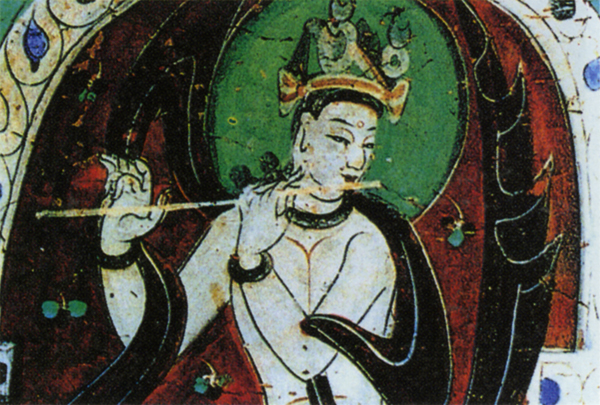From caves to the stage
By Chen Jie | China Daily | Updated: 2017-09-11 07:50
 |
| Dancers from the National Ballet of China rehearse for Dunhuang, which is inspired by the Buddhist art and frescoes in the Mogao Caves. JIANG DONG/CHINA DAILY |
Choreographer Fei Bo brings to fore the stories of people associated with preserving Dunhuang's grottoes in a new ballet. Chen Jie reports.
Flying apsaras (supernatural entities in Hindu and Buddhist mythology) on the ceilings of the Mogao Caves in Dunhuang have inspired many dancers-and Fei Bo is no exception.
But what impressed the Chinese choreographer most about the caves, which are located in Northwest China's Gansu province, was what was behind the preservation of the Buddhist art and frescoes.
He has returned to the caves once every year since his first visit to Dunhuang in 2012. He's inspired by stories of people who have preserved the artworks. And he has created a ballet about them.
The National Ballet of China will premiere Dunhuang at the Tianqiao Theater in Beijing on Sept 19. It'll show in the capital for three days and then tour Gansu from Sept 27 to 28.
When Fei first visited the Mogao Caves, a tour guide told him most of the archaeologists who initially worked there were buried in a nearby desert.
The first batch of experts who came to Dunhuang were 20 years old or younger. They spent all their lives there, discovering sculptures, preserving the artworks and restoring the caves.
"The guide's words lingered in my mind. And I asked for more stories," recalls Fei.
Curiosity lured him back in 2013, when he visited the Dunhuang Research Academy that manages the caves.
 |
| Dancers from the National Ballet of China rehearse for Dunhuang, which is inspired by the Buddhist art and frescoes (above right) in the Mogao Caves. |
The academy's former director, 79-year-old Fan Jinshi, shared with Fei the adventures of the first archaeologists and artists. The academy was founded in 1944 by artist Chang Shuhong (1904-94).
In 1935, in an old bookstore along the Seine River in Paris, Chang, who then lived in France, discovered a photograph featuring hundreds of Dunhuang paintings and manuscripts. It was written by Paul Pelliot, the late French Sinologist, who is known in the West for rediscovering Dunhuang.
Chang didn't know about the caves that contain some of the finest examples of Buddhist art that spans over 1,000 years.
He returned to China to study and preserve the Dunhuang grottoes.
Chang arrived in Dunhuang in early 1943. He endured poor living conditions. He lived in a dilapidated temple where his bed, desk and chairs were made of clay.
The place didn't have electricity. And the nearest village was a long walk away. Chang's wife couldn't stand it. She left him and their two children.
But Chang stayed. He even encouraged his son and daughter to join his mission. He also trained young archaeologists, such as Fan, Sun Ruxian, Li Qiqiong and Guan Youhui.
Fan joined the academy after she graduated from Peking University's archaeology department in 1963. She focused on studying the Mogao paintings from the Northern Dynasty (386-581) up to the Tang Dynasty (618-907).
Fan became the academy's third director in 1998.
Fan and the others worked day and night. After sundown, they observed the paintings in the light of an oil lamp and copied them on paper.
"The oil lamp also lit up everybody's heart," Fan says.
 |
| Dancers from the National Ballet of China rehearse for Dunhuang, which is inspired by the Buddhist art and frescoes in the Mogao Caves. JIANG DONG/CHINA DAILY |
Sun, who's now 92, joined the academy in September 1947 at age 22. He worked on rebuilding the caves. His wife, Li Qiqiong, worked there for more than 60 years after arriving in Dunhuang in 1952 to study and copy the paintings on the walls.
Sun told Fei that he carried a wooden stick to guard against wolves in the area when he and Li went to the caves in the evenings.
Guan, the archaeologist, showed Fei a group photo taken in the 1950s. Only two of the people in the photo, including Guan, who's 87, are still alive.
The experts forgot about how tough life was back then when they focused on the art, Guan told Fei.
Such anecdotes formed the basis of Fei's ballet that is set in a place of blue skies and yellow desert. It portrays a group of passionate young people devoting their lives to art.
"The experts must have felt lonely in the desert. But they put their hearts into the work," says the choreographer.
Composer Guo Wenjing created the score.
"To me, Dunhuang-the place and the desert-are just the background. I focus on the people. From my score, you can hear a story about ideals, beliefs, youth and love," he says.
The 61-year-old is one of China's best-known composers. He and his peers, including Tan Dun, Zhou Long, Chen Yi, Ye Xiaogang, Qu Xiaosong and Liu Suola, were the first students to be admitted to the Central Conservatory of Music in 1978, after the "cultural revolution" (1966-76).
Many from that batch went to Western countries to study classical music. Guo chose to stay in China. His music combines traditional Chinese folk elements and Western composition techniques.
"This piece will be the most romantic among all my works. The paintings, the flying apsaras, the desert and the blue sky will be written as the colorful timber to reinforce love, sadness, union and separation," says Guo.
























